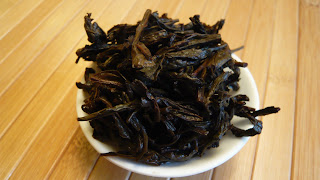To me, comparing these 3 Dan Cong's with different ages is an interesting experience.
The first one is a 1994 Dan Cong, cultivar unknown.
The dry tea leaves look dark and heavy. In my eyes, the appearance is not much different from a Dan Cong of a recent year. The smell is very pleasant. When I get an aged oolong, what I care the most is, I don't want it to smell either damp or burnt.
Considering the tea looks heavy and the leaves may expand dramatically, I used only less than 1/2 gaiwan-ful of dry leaves. It turned out to be a fair amount. The dominant impression I got from the first a few infusions was sweetness. The tea is very, very sweet. I don't remember having any other non-puerh tea that's so sweet. The tea also has some herbal aroma. Like some other aged oolong that I appreciate, the tea has rich flavor, but feels easy and soothing on stomach. The tea has some typical "flavor of age", which is enjoyable to me as it doesn't taste damp.
The less than 1/2 gaiwan-ful of dry leaves, after being spent, became about 4/5 gaiwan-ful. Usually I would like to see spent leaves loosely filling the gaiwan, without being tightly packed. In a later tasting, I used a little more than 1/2 gaiwan-ful of leaves, and decided that for this tea, I would prefer using smaller amount of tea leaves.
This tea seemed to last forever. But later infusions were much lighter. So I ended it at certain point. Overall, the sweetness in the first several infusions was very prominent, surprisingly prominent. In later infusions, the sweetness was still there, but felt more "regular". When the sweetness faded, the herbal and woody flavors stood out more. The tea leaves expand little by little over infusions. From the spent leaves, it looks like I should have gone for some more infusion to fully use these leaves.
The second one is a 2002 Dan Cong, cultivar unknown, but flavor is within the range of Milan (honey orchid) Dan Cong.
The dry tea leaves and liquor color are not that much different from un-aged dark roast honey orchid Dan Cong - however, most of the dark roast Dan Cong's are made into dark roast at the end of its harvest year, so sometimes the age of an un-aged dark roast Dan Cong is not obvious to me.
The flavor of this tea bears only a hint of "flavor of age". It has a lot more uprising aroma than the first one. Actually I was quite surprised a 9-year old tea could retain so much aroma. In my impression, the uprising aroma of a tea would disappear gradually as the tea ages. One thing that has made me feel unsure of aged oolong is, I often love the uprising aroma of many oolongs and don't want to let it disappear in aging.
Overall I like this tea very much, but if I were not told the age of the tea, I don't think I could have guessed even a rough figure of its age. It tastes warmer than newer oolong, and the light "flavor of age" may serve as a hint. But I don't have enough experience to tell if it's 5 years old, or a little more, or much more. Besides, from its well-maintained aroma, I guess this tea has been stored in a relatively dry and well-sealed environment. Would I like it as well if it were at its third year? Very possibly! In this sense, I am not sure if I like this tea because it's aged, or because it's well-made from the beginning and well-preserved afterward. I think that's a constant question I have with quite a few aged oolongs and that's one of the major reasons I have been unsure about aging oolongs.
I started out to write a blog about the first tea, the 1994 Dan Cong. Then I got the 2002 Dan Cong and thought the two aged Dan Cong would be an interesting comparison. Then, one day I heard of this Dan Cong of 40-50 years in age. It's not something one can bump into frequently, and it's from a farmer I personally know. So even though I wasn't in a mood of collecting aged Dan Cong, I decided to get some just for the sake of experiencing it. So I will review it and continue the comparison in a short while!
六堡茶道美学煮茶
3 years ago







































2 comments:
I tried the 1994 dan cong last week. Unfortunately, I didn't get a whole lot from it other than a slightly musty "old" flavour and aroma. Definitely no sweetness. I used a tiny gaiwan, so I still have half the sample. I'll brew the rest and report back on whether it improved after airing out a bit.
Reporting back:
I tried the 94 again today after about three months of airing out, and I think the result is considerably better. I'm getting a lot of sweetness, dried fruit, wood, herbal medicinal flavours, and a bit of musk. It tastes old and grand.
I am not yet sure if I like this style of tea. It's the only aged dan cong I've tried, and the flavours are so different from everything else I've had that it's like learning to appreciate it all over again. I can absolutely understand the appeal.
I used 4 grams in 60ml, with quite short infusions.
Post a Comment